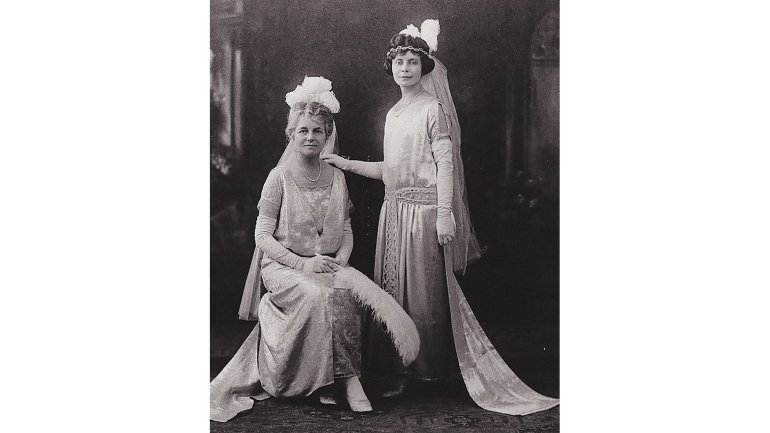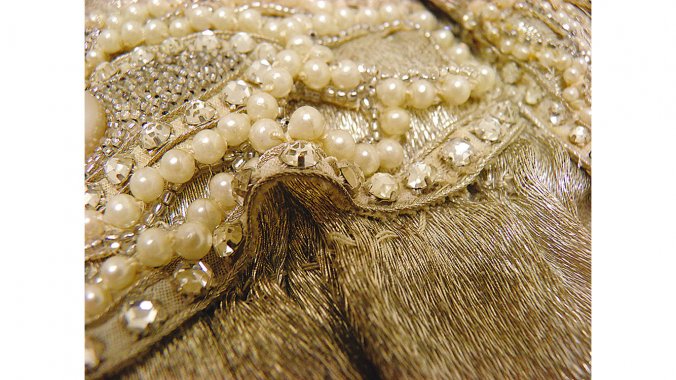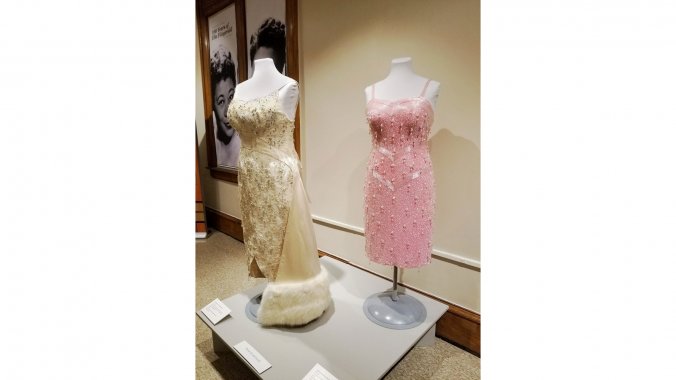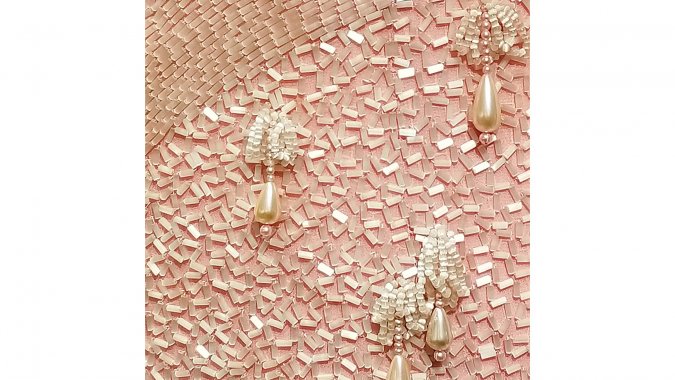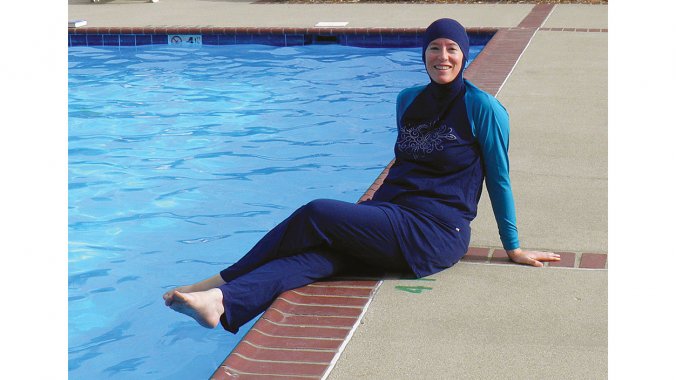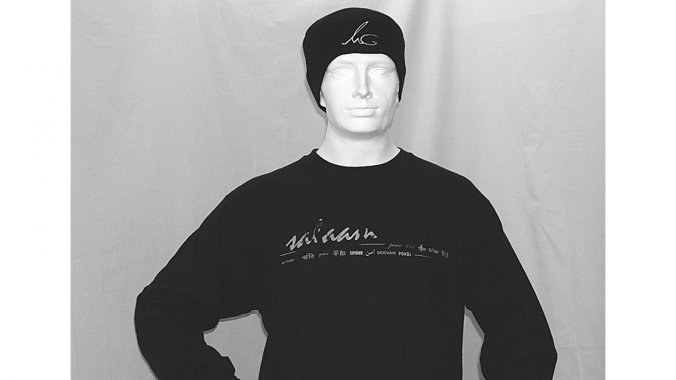The Elizabeth Sage Historic Collection
From American Craft Inquiry: Volume 2, Issue 2
In the study of fashion design and fashion history – a discipline driven by close observations of images and objects1– fashion collections are vital resources for teaching, exhibitions, and research. In North America, some of the largest collections related to fashion are at the Metropolitan Museum of Art, the Museum at FIT, the Royal Ontario Museum, the Chicago Historical Society, and the Bata Shoe Museum in Toronto. There are also several universities with significant collections, including Drexel, Kent State, Cornell, the University of Rhode Island, and the University of Minnesota.
Although the fashion industry is heavily globalized and has been for centuries, most fashion collections in Europe and North America collect mostly (or even exclusively) from the West. Fashion scholars are beginning to recognize other global fashion systems – including Asian fashion,2 African fashion,3 and Islamic fashion4 – but this absence of non-Western examples in fashion collections continues to be a barrier to research on the history of fashion outside of Western capitalism.5 Even our ability to study the history of Western fashion has been skewed by a predominance of objects from white, middle- to upper-class, cis-gender, native-born, well-educated donors.
In 2017, I took over from Kate Rowold as the director of the Elizabeth Sage Historic Costume Collection at Indiana University, one of the oldest and largest university-based collections of costume and fashion. This article explores the history of the Sage Collection, focusing on Elizabeth Sage and how she developed the collection to support her innovative classes on costume history, how the collection came to exclude non-Western fashion, a look at the needs of contemporary researchers, and my efforts to expand the collection in new ways by fostering new kinds of donor relationships.
Elizabeth Sage: Fashion history pioneer
Elizabeth Sage was born in 1868 in Buffalo, New York, just 20 years after the famous Seneca Falls Convention on women’s rights in upstate New York led by suffragettes such as Elizabeth Cady Stanton. Perhaps inspired by that atmosphere of political activism, when Sage finished her high school diploma she made the bold move of heading to New York City and continuing her education at Columbia University. In 1902, she earned a “bachelor’s diploma” in home economics, staying there to teach for the next eight years. In 1913, when the board of trustees at Indiana University decided to establish a department of home economics – which would be shared between the College of Arts + Sciences6 and the School of Education – the first professor they hired was Mabel Wellman, a graduate of Wellesley College. As a home economist with expertise in cooking and nutrition, Wellman was recruited both to teach and to chair the new department. The second professor, Elizabeth Sage, was hired to teach classes on textiles, clothing construction, and other aspects of the “domestic arts.”
A bulletin published by Indiana University in 1915 describes the new department as aiming to
… meet the needs of two classes of students: of those who wish to study the principles and processes involved in the science and the art of home-making; and of those who wish to teach, or to supervise, home economics in the school.7
In many cases, the students who had an interest in teaching were already employed as teachers; they were attending classes at IU during the summer to earn a bachelor of science degree, which at the time was the highest degree offered.8 Students taking classes during the regular term were more likely to be working toward a bachelor of arts degree – intending (perhaps) to work, but ultimately to get married and become homemakers. Although “ready-to-wear” clothing was just starting to appear in catalogues and stores in major cities, many women were still making their own textiles, clothing, and furnishings for their households. This made skills such as knitting, weaving, sewing, and fashion design highly desirable for future wives and mothers.
While her students seem to have regarded Elizabeth Sage as having9 “good taste, refinement, courtesy, thoughtfulness and generosity,” she was also a scholar and a pioneer in the study of fashion history. IU’s bulletin for 1917 shows her teaching applied design, a five-credit class on advanced dressmaking, clothing laboratory, a graduate class on “the Teaching of Domestic Art,” and another five-credit class on the history of costume and costume design. In 1924, she wrote to the university’s president, William Lowe Bryan, asking for a sabbatical in order to advance her research:
My Dear Dr. Bryan:
May I ask for a leave of absence for the second semester of next year? I am anxious to spend the time abroad, studying historic costume, and other subjects connected with my work here. . . . I understand that this will have to be acted upon by the Trustees, so I am putting in my request rather early.
Yours sincerely,
Elizabeth Sage
In an interview for the student newspaper, she described the plan for her sabbatical as sailing from New York to Spain, Portugal, Tunisia, Egypt, and Greece, then traveling through Italy and Holland to spend several months in Paris.10 At President Bryan’s recommendation, the board of trustees gave the department of home economics a special fund of $10011 so that Sage could purchase textiles and clothing during her trip to use as examples in her classes.12
In 1926, she published one of the first textbooks on the history of fashion, A Study of Costume.13 The first chapter focuses on ancient Egypt – drawing illustrations from an earlier book, Costume of the Ancients,14 by Thomas Hope – but Sage also included some observations from her own travels.
The women of modern Egypt wear black when appearing out-of-doors. Among the lower classes even the face-veil is black, with a curious brass cylinder in the center of the forehead, having one, two, or three rings, depending upon whether the woman is single, engaged, or married. Color is supplied by the men, who are very gay in their long, broadcloth coats of green, blue, violet, and deep red, their broad sashes, and cashmere scarfs, which they throw carelessly over their shoulder in the daytime, and use to cover their head and neck as soon as the sun has set.15
While she used the term “fashion” in her book, Sage described it negatively as a “fad” that would not stand the test of time,16 urging her readers to concentrate on sensible styles of clothing with “long, sweeping lines and good color”17 that could be worn for many years. The back of the book has 10 pages of patterns for constructing a range of historic garments, including a frock coat, doublet, cape, shirtwaist and a Japanese kimono. Clearly, Sage wanted her students to incorporate their lessons on the history of fashion into their designs – a practical approach for a professor of textiles and clothing in the early 20th-century – but she was also open to learning about non-Western styles of dress. In 1934, she took another sabbatical in order to travel and study abroad.18
When she retired in 1937, Elizabeth Sage gave her collection to the department of home economics, which eagerly accepted it and continued to use it as a resource for teaching. Upon her death in 1959, the university noted:
Since her retirement this collection has been enlarged by gifts from her personal friends and friends of the Department of Home Economics. It is now known as the Elizabeth Sage Historic Costume Collection and is considered to be exceptionally fine.19
Growth of the collection and changes in mission
In 1966, an appraisal conducted for insurance purposes showed that the Sage Collection contained four ”Oriental Costumes” valued at $1,600 and ”20 Boxes of National Costumes” valued at $630 – nearly 9 percent of the total value, which was estimated at $25,336.20 A brochure produced by the department of home economics in the 1970s or early ’80s21 describes the Sage Collection as an “academic resource” used by ”students, faculty, and independent researchers studying fashion history, apparel design, conservation, and the social and cultural aspects of clothing.” It also describes how the collection had grown from ”several hundred” pieces to more than 4,000.
The collection’s primary emphasis is American culture including both everyday and high fashion clothing. In addition, clothing and textiles from other Western as well as non-Western cultures form an important part of the collection.22(emphasis mine)
By 1992, when the collection was being packed and moved from its original location in Wylie Hall to a facility off campus, a press release noted that it had grown to 12,000 pieces with a value of more than $3 million.23 Without mentioning any non-Western dress, the assistant curator, Pat Roath, observed that the collection contained many unique and “irreplaceable” artifacts such as a child’s linen waistcoat from the mid-1700s, a jacket worn by Hoagy Carmichael, a “Rosie the Riveter” factory uniform from World War II, and high-end fashions from many famous designers.
By the time I began as director, the collection had doubled again in both size and value. However, the focus had been deliberately narrowed to exclude non-Western fashion. As described in a report to the new dean of the School of Art, Architecture + Design,24
Objects in the Sage Fashion Collection originate from the late 18th-century through the early 21st-century. Men’s, women’s, and children’s clothing, accessories, and related items illustrate fashion cycles and textile innovations in the United States and Western Europe. Flat, domestic textiles are not within the Sage collecting policies, nor are national dress and textiles from other continents.25(emphasis mine)
Although the Sage Collection had never been very active in collecting examples of non-Western dress and fashion, this gradual exclusion can be partly explained by the collection’s increasing collaboration with the Mathers Museum of World Cultures, which was founded at IU in 1943 and moved to its present location on campus in 1983.
At some point in the 1980s, the directors of Mathers and Sage came to an informal agreement: Mathers would transfer its holdings of Euro-American clothing and accessories to the Sage Collection, while Sage would transfer any non-Western artifacts to the Mathers. The goal was to avoid duplications of efforts, streamlining their missions and maximizing the use of storage.26 In 1985, the Mathers transferred 110 articles of clothing to Sage; in 1988, Sage transferred 72 “quilts and textiles” to Mathers. The largest transfer happened in 2008, when Sage transferred “177 non-Western textiles.” Among those objects were the four “Oriental robes” mentioned in the 1966 appraisal.27
On the surface, this seems like a very practical move. No museum can collect everything that might be interesting to future students and scholars, particularly objects like clothing and accessories that are so ubiquitous in society. Only a tiny proportion of the items that are currently being worn will ever end up in a museum. As a public university, IU has a responsibility both to educate and to be responsible stewards of funding. Although the Mathers Museum still collects textiles, clothing, and accessories, it emphasizes these artifacts as examples of material culture, attempting to honor the vast diversity of cultures in the world. Sage, on the other hand, focuses on how styles of clothing and accessories change over time, in part due to culture, but also due to technological innovations in design and manufacturing. Collecting “culture” is different from collecting “history.”
As a category of objects, fashionable dress is particularly difficult to collect. It changes rapidly, can be very expensive, is often difficult to store, and, like art, high-end fashion pushes the boundaries of mainstream culture. Some of it will change the way all of us dress; much of it will not. It takes special expertise to recognize which trends may or may not be valuable in the future. On the issue of funding: the V&A has started a special fund for collecting examples of contemporary design, asking patrons to tweet ideas about acquisitions that would highlight “different questions about globalisation, popular culture, political and social change, demographics, technology, regulation or the law” using the hashtag #rapidresponsecollecting.28 Although the Mathers Museum does not exclude fashion from its collection (and, in fact, is very open to textiles, clothing and accessories), it does not make any special effort to collect fashion. Unfortunately, when the Mathers and Sage agreed to split their collections on the basis of geography, it reinforced a major stereotype in the discipline of fashion studies – that “fashion” is Western and “culture” is non-Western.
New directions for the Sage Collection
Elizabeth Sage was a pioneer in the study of fashion, but she was also simply a pioneer, as a woman in a male-dominated institution of higher education. In many ways, the Sage Collection can be viewed as a celebration of objects made and used by women; our collection of men’s fashion is tiny compared to the amount of clothing and accessories for women. In other ways, however, the Sage Collection is agonizingly narrow, dominated by acquisitions from white, middle- to upper-class, cis-gender, native-born, well-educated donors. While the demographics of the US have changed dramatically since the Sage Collection was founded, working-class and minority histories are barely represented. Although fashion history has gained legitimacy as an academic area of study, the shape of the collection has a tremendous impact on research and teaching opportunities. Because the Sage Collection is an organization within a nonprofit university, its growth is entirely dependent on donors. In 2017, the collection acquired 419 new objects from 18 donors; five were employees of Indiana University, but the others also had connections (alumni, parents, or friends). The chances that someone with no connections to the university would know about the Sage Collection and offer to make a donation are unfortunately quite small. Of course, the demographics of universities like IU are skewed compared to the general population. According to Census data published in 2017,29 only 12.8 percent of adults in the US have some kind of graduate or professional degree. While the numbers are fairly even for men (12.7 percent) and women (13.0 percent), they vary significantly by race. Only 8.8 percent of black Americans and 5.0 percent of Hispanics (of all races) have a graduate or professional degree, while 24.3 percent of Asian Americans do. This lack of familiarity with graduate education and research universities in certain populations contributes to the blind spots we have in the Sage Collection.
While the existing collection is a gem worth preserving, one of my goals as director of Sage is to make connections with new donor communities and to begin diversifying the collection. For example, as a convert to Islam and a scholar of contemporary Islamic fashion, I’ve published articles about the clothing choices of Muslims in the US,30 which are connected to fashions from the Middle East but shaped by the unique context of the US. I’ve already begun donating pieces from my research and personal collection, including a head covering for athletes made by the Dutch company Capster; three outfits from Macy’s launch of an Islamic fashion collection in 2017 (the first mainstream corporation in North America to do so); casual garments for men (a cap, shorts, and two shirts) sold by Canadian retailer Muslim Gear; and an authentic “burqini” designed by Aheda Zanetti, an Australian woman of Lebanese descent.31
I also have plans to develop relationships with new donor communities in rural Indiana. Fashion theory postulates that styles typically “trickle down” from upper-class to lower-class (with some exceptions such as blue jeans), but is that really true today? Having grown up in the rural Midwest, I suspect that there are rural, working-class styles and histories of fashion that have simply not been well represented in fashion collections. Another target that I have in mind is “cosplay,” a rapidly growing global subculture full of passionate designers making fantastic and technically complicated costumes for role-playing.32 Is any museum collecting these? I’m fortunate to know a prominent scholar of fashion, Therèsa Winge, who does research with cosplayers in the US and can facilitate the necessary connections. As the director of Sage and as a scholar and teacher of fashion studies, I feel a responsibility to grow our collection in new ways that will support more diverse research and teaching in the 21st-century and beyond.
Read more from the fourth issue purchase issue
1. Lou Taylor, The Study of Dress History (Manchester: Manchester University Press, 2002).
2. Sandra Niessen, Ann Marie Leshkowich, and Carla Jones, eds., Re-Orienting Fashion: The Globalization of Asian Dress (London: Berg, 2003).
3. Victoria Rovine, African Fashion, Global Style: Histories, Innovations, Ideas You Can Wear, Bloomington: Indiana University Press, 2015).
4. Heather Marie Akou, “Building a New ‘World Fashion’: Islamic Dress in the Twenty-first Century,” in Fashion Theory 11(4) (2007): pp. 403-421.
5. Linda Welters and Abby Lillethun, Fashion History: A Global View (Bloomsbury: Oxford, 2018).
6. At that time, the College of Arts & Sciences was named the College of Liberal Arts.
7. pp. 192.
8. Ruth M. Griswold, A History of Home Economics in Indiana, (Indianapolis: Indiana Home Economics Association and State Department of Public Instruction, 1963), pp. 42-43. Indiana University did not offer a graduate degree in home economics until 1926.
9. Mabel T. Wellman, Henry Lester Smith, and Una Lane Robinson (1959), “Memorial Resolution on the Death of Professor Elizabeth Sage,” C598, Box 2, “Sage, Elizabeth,” Indiana University Archives, Bloomington, Indiana.
10. (January 21, 1925), “Instructor Writes Book on ‘Costumes,’ ” The Indiana Daily Student, transcript by Indiana University Archives.
11. This would be equivalent to approximately $1,500 in 2018.
12. (1913), “Minutes of the Board of Trustees of Indiana University, 13 March 1925, 7:30 pm,” Indiana University Archives, http://purl.dlib.indiana.edu/iudl/archives/iubot/1925-03-13.
13. New York: Charles Scribner’s Sons.
14. (1809), London: Printed for William Miller by W. Bulmer.
15. pp. 11.
16. pp. 214.
17. pp. vii.
18. (June 8, 1934), Letter from William Lowe Bryan certifying Elizabeth Sage as a representative of Indiana University “during her travels and study abroad.” C598, Box 2, “Sage, Elizabeth, 1923-1937,” Indiana University Archives.
19. Wellman et al, p. 5.
20. Lillian R. Burnett (1966), Appraisal of the Elizabeth Sage Historic Costume Collection, C598, Box 2, “Elizabeth Sage Historic Costume Collection,” Indiana University Archives.
21. Department of home economics (undated), “Elizabeth Sage Historic Costume Collection,” C598, Box 2, “Elizabeth Sage Historic Costume Collection,” Indiana University Archives. In 1984, the department was split into two new departments: apparel merchandising and interior design (which stayed in the College of Arts & Sciences) and applied health sciences (which was placed in the School of Health, Physical Education, and Recreation, now known as the School of Public Health).
22. p. 1.
23. Joanne Nesbit (February 3, 1992), “Packing Contents that Would Fill Nearly 150 Closets Faces Curator of Historic Costume Collection,” IU News Bureau, C598, Box 2, “Elizabeth Sage Historic Costume Collection,” Indiana University Archives.
24. The School of Art, Architecture + Design was formed in 2016 by merging the department of studio art with the de partment of apparel merchandising and interior design (home to the Sage Collection). In 2016, the university also hired its founding dean, Peg Faimon.
25. (2017), “2016-2017 Report,” The Sage Collection. Author’s personal correspondence.
26. Personal communication with the curators of Sage ( Kelly Richardson) and Mathers (Ellen Sieber).
27. Communication with Ellen Sieber, June 27, 2018.
28. “Rapid Response Collecting,” Victoria & Albert Museum, London, https://www.vam.ac.uk/ designandpubliclife/projects/rapid-response- collecting/?gclid=Cj0KCQjwjtLZBRDLARIsAKT 6fXw7-SzrsTskxAqaUC0gLiDGh8Eh7s4DFyhrla55n6xn JCUMTD9NjRQaAtOWEALw_wcB, accessed June 2018.
29. “Educational Attainment in the United States: 2017,” United States Census Bureau, Washington DC, https://www.census.gov/data/tables/2017/demo/ education-attainment/cps-detailed-tables.html, accessed September 2018.
30. “Becoming Visible: The Role of the Internet in Dress Choice Among Native-Born Converts to Islam in North America,” HAWWA, 13(3) (2015): pp. 279-296.
31. “A Brief History of the Burqini: Confessions and Controversies,” Dress, 39(1) (2013): pp. 25-35.
32. Therèsa M. Winge, Costuming Cosplay: Dressing the Imagination (London: Bloomsbury Academic, 2018).


